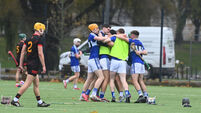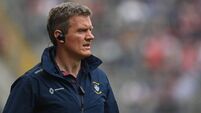The geography of the pitch has changed as hurlers play the percentages

Waterford are one of the best teams to shoot from distance. In their recent league game against Galway, Calum Lyons scored 0-5 from play from wing-back. In last year’s championship, Waterford defenders scored 1-13 from play, including Lyons' goal against Cork. Picture: Piaras Ó Mídheach/Sportsfile
A couple of years back, the hurling coach and statistician Seán Flynn did a brilliant study on retention rates in hurling through analysing deliveries from different zones of the pitch.
From a series of games during the 2017, 2018, and 2019 championships, Flynn analysed 5,297 passes to highlight the breakdown in retention rates of those passes.
Studying the data from four different zones, the results were revealing.
When the ball was struck behind the 45-metre line, the retention rate was 33%; between 45-55 metres, it was 42%; when the ball was delivered between 55-65 metres, the retention rate was 58%; when the pass was played between both 65 metre lines, forwards were winning 73% of that possession.
Flynn’s more nuanced detail around the data also illustrated how the game was changing throughout those three seasons. In 2017, the number of deliveries from inside a team’s own 45 to inside the opposition 65 metre line was 13.8 per game; by 2019, that figure had dropped to 7.41. Moreover, the retention rate had also significantly dropped throughout those seasons, going from 36% in 2017, to 34% in 2018, all the way down to 31% in 2019.
The geography of the pitch is becoming increasingly altered with extra bodies and layered defences. Having the high percentage scoring zones so heavily populated with extra bodies has encouraged more shooting from distance but it has also forced players to put a far greater premium on processing possession closer to goal. “Teams were holding their half-back line,” says Flynn, who worked as a statistician with the Tipp senior hurlers in 2019 and 2020. “Half-forwards were dropping deep but the ball was still going long. Now, teams are looking to hit those passes into half-forwards in the middle third. As a result, opposition half-back lines have serious questions to answer in terms of their overall structure.”
The systematic processing of possession now lies at the heart of hurling’s modern conflict. The public crave more contests for the ball, but the players just want to eliminate as many of the variables as possible by moving the ball into shooting positions.
In a recent excellent paper by Paul O’Brien and assisted by Denise Martin and Johnny Bradley published in the , O’Brien aimed to create a profile of elite performance to identify which indicators discriminate between winners and losers in senior inter-county hurling championship.
Significant differences were identified in shooting indicators, with winning teams having higher total shot count (40), shot count from open play (29.5) and shot efficiency from both open play (61%) and dead balls (77%). “This information really helps our understanding of the game and how hurling is constantly evolving,” says Denise Martin, of the Technological University of Dublin, who has championed and led statistical data analysis in the GAA over the last decade. The reason why this is so important is that we can stand over it. The data is robust. It’s checked. There is a reliability study with it.”
Despite so much indifference now to how the game has changed, nobody can deny how hurling has evolved, and is continuing to evolve. A few years back, Colm Clear, Martin, and Professor Mike Hughes brilliantly explored the composition of possessions and shooting in the entire 2015 hurling championship, highlighting the importance of increasing shot count, shot efficiency, and successful free takers.
However, the change of the hurling championship to a provincial round-robin system in 2018 and 2019 may have had an impact on comparisons between Clear’s findings and O’Brien’s latest data.
While there is no difference in shots from play, and only a minimal difference in total shots, the analysis shows that shooting efficiency has improved considerably since 2015. The total shooting efficiency of losing teams (59%) has stayed consistent with the previous figure (58%). However, the figures for winning teams has increased from 62% up to 65%. The improvement in shooting efficiency for winners is also evident with shots from open play, increasing from 58% to 61%.
Successful teams are placing more emphasis on better shot selection, both in terms of location and execution.
“Getting more shots off from play, and getting them off in better zones is becoming more and more important,” says Paul O’Brien, who undertook the study research as part of his Masters in Sports Performance Analysis in IT Carlow. “It’s no surprise that the most accurate teams over the last three years were Limerick twice, and Tipperary. But they were also the teams which got off the most shots in the best scoring zones.
“A lot of people are giving out now about the huge volumes of scores, but the coaching has got better because it had to. With so many extra bodies now in the middle third, why wouldn’t coaches design games to improve shooting?”
O’Brien’s findings also show the various areas where scores originate from and the importance of being able to transition from defence to attack and attack to defence. Teams want to work the ball to better shooting positions, but the natural corollary is that areas close to goal have never been more congested with bodies.
One of the trade-offs is that the scoring zone has never been so big. Changes in the sliotar and increased levels of strength and conditioning has also further expanded the scoring zone.
The increased redrawing and expansion of the tactical grid has led to a decreasing number of goals and more long-distance shooting. So many teams now have so many good outside shooters that they don’t need to work goals, especially when three quick points has the same mathematical value.
Shooting from distance, especially accurately, is now a skill in itself. It’s also more logical with so many teams now playing with deep-lying forwards or retreating midfielders. With half-forwards and midfielders dropping back under puckouts, and covering back in other scenarios, half-backs have become increasingly available in space to attack and shoot.
Waterford are one of the best teams to shoot from distance. In their recent league game against Galway, Calum Lyons scored 0-5 from play from wing-back. In last year’s championship, Waterford defenders scored 1-13 from play.
Brilliant data from the excellent ‘GAA Insights’ team revealed how Waterford took an average of 9.8 shots per game in the 2020 championship from outside the 65 metre line, which accounted for 41% of their average total number of shots per game. As a comparison, Limerick’s percentage of shots scored from outside the 65 metre line amounted to 26% of their total score.
Wexford were the highest shooters from distance in the 2020 championship, when averaging 11 shots from play from outside the 65, which amounted to 63% of Wexford’s total shots from play.
Wexford’s style, especially with Kevin Foley’s role as the sweeper, encourages more shooting from distance. Yet the high volume of long-range shooting last year (six of the 10 teams in the Liam MacCarthy had over 40% of their total shots from outside the 65-metre line) captured another step in the game’s evolution.
“With many teams employing more complex defensive system with congested defences,” writes O’Brien in the study, “attacking teams need to be aware of the trade-off between shooting from the midfield zone with potentially lower shot efficiency than risking additional turnovers by advancing to the attacking third where scoring efficiencies increase.”
The evolution continues. And so does the revolution.














